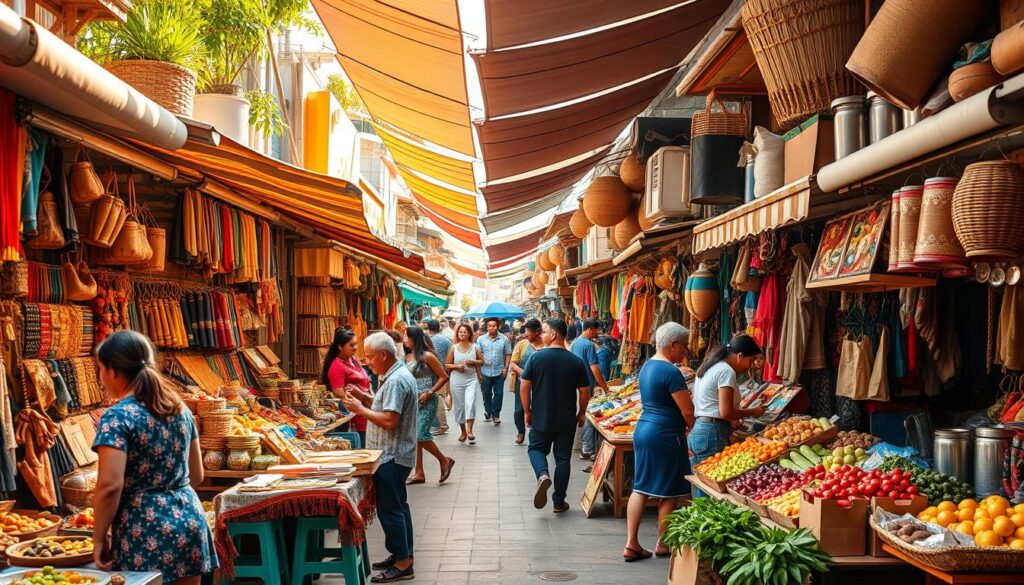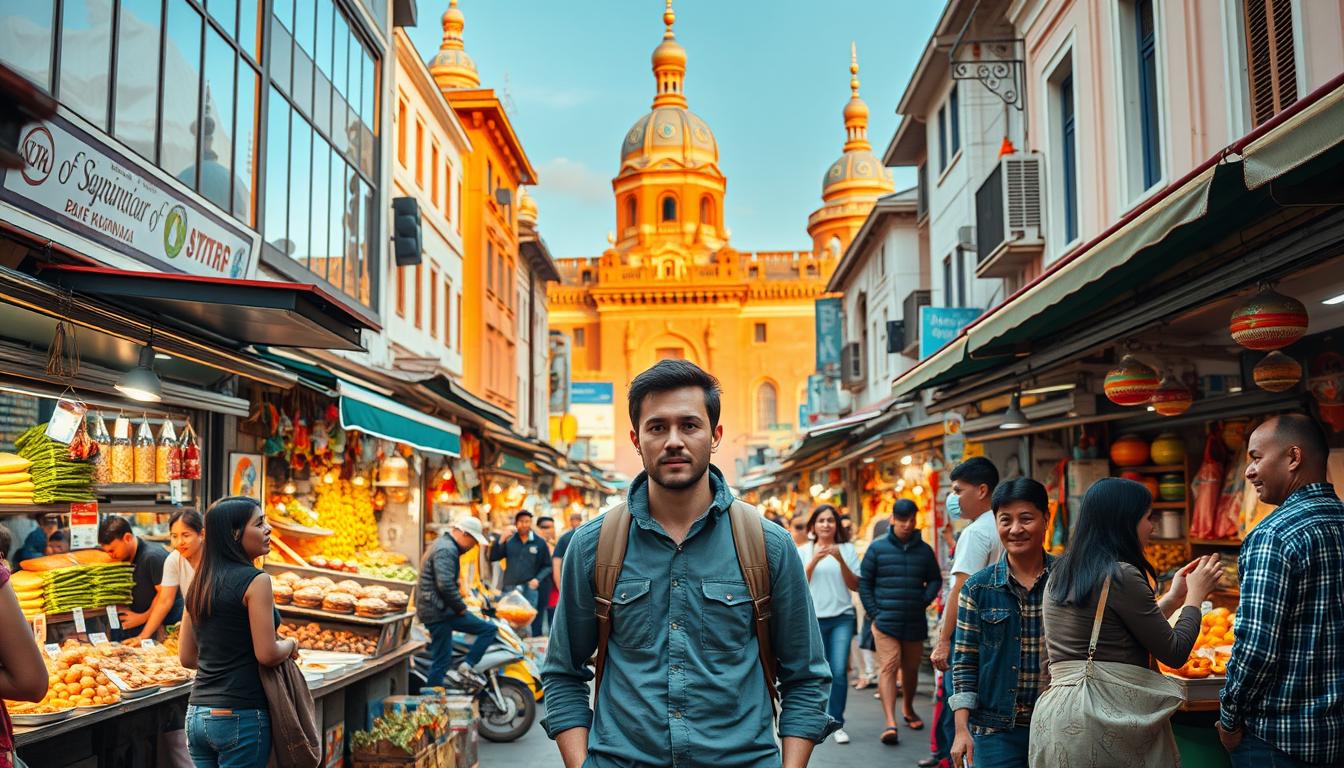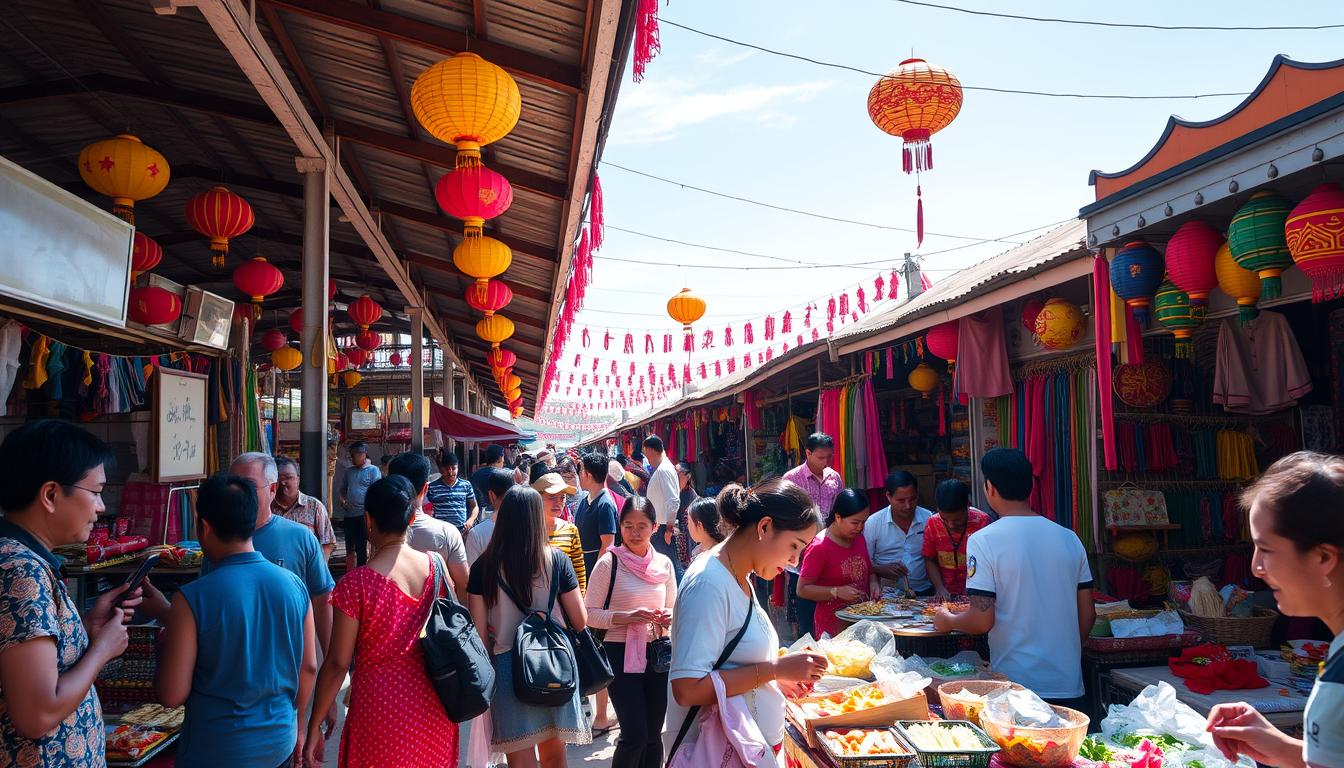Table of Contents
ToggleExploring new places through cultural experiences can change us deeply. When we dive into a new culture, we see things from different angles. This broadens our view of the world.
The Cultural Iceberg Model shows us that what we see is just a tip of the iceberg. Beneath lies the true heart of a culture, its values and beliefs.
Getting to know a new culture can make us think deeply about ourselves. It helps us understand the world in a more detailed way. This is good for anyone, whether they live abroad or just want to learn about other cultures.
Key Takeaways
- Cultural experiences significantly impact personal growth and understanding.
- Exposure to new perspectives challenges individual assumptions and values.
- The Cultural Iceberg Model highlights the significance of the unseen aspects of a culture.
- Immersion in a new cultural environment can lead to self-reflection and a broader worldview.
- Exploring different cultures benefits individuals living abroad, planning to relocate, and those simply curious about the world.
Understanding Cultural Immersion: More Than Just Tourism
Cultural immersion is more than just visiting places. It’s about diving deep into local customs and traditions. This experience helps us understand a community’s cultural meaning and cultural capital.
It broadens our view of a place’s cultural history and cultural resources. It also helps us connect with the local culture in a meaningful way.
The Cultural Iceberg Model and Its Impact
The Cultural Iceberg Model shows that culture has both visible and hidden parts. The visible parts, like language and food, are easy to see. But the deeper values and beliefs that shape a culture are harder to spot.
To really get to know a new culture, we need to explore these hidden parts. This leads to a deeper understanding of the cultural meaning and cultural resources of a community.
Also Read : How Can A Travel Medical Assistant Support Healthcare Facilities In Different Locations?
Breaking Down Cultural Barriers
Cultural immersion is about more than just watching. It’s about actively engaging with the local culture. This requires an open mind, a desire to learn, and respect for the host community’s cultural capital.
By embracing new customs and traditions, we gain a deeper insight into a place’s cultural history and cultural meaning. This fosters cross-cultural exchange and personal growth.
The Role of Self-Awareness in Cultural Exchange
Self-awareness is key in cultural exchange. Recognizing our own biases and cultural lenses helps us navigate new environments better. This self-awareness leads to more meaningful interactions and reduces misunderstandings.
It makes our cultural experience more enriching and transformative.
“Embracing unfamiliar culture can be a transformative experience, fostering personal growth and empathy.”
Also Read : How Does Remote Work Part Time Impact Work-Life Balance?
The Psychology Behind Cultural Experiences

Cultural experiences deeply affect our mental health. They can make us feel excited, curious, or even uncomfortable. The idea of “culture shock” was first talked about by Cora Du Bois in 1951. It’s about feeling lost when we meet new cultures.
Kalervo Oberg later added to this idea. He said we go through four stages when we meet a new culture. These stages are the honeymoon, regression, adjustment, and recovery. They show how we grow and learn from new experiences.
Cultural psychology brings together many fields to study how culture shapes our minds. It shows how different cultures view time, space, and emotions. This field helps us understand how our culture influences us.
Also Read : Unlock Opportunities With PSU Exams Jobs
“Cultural differences can be informative to mainstream psychological theorizing,” as highlighted by Steven Heine from the University of British Columbia.
But, studying culture is not easy. Most studies focus on people from Western cultures. This limits what we know about other cultures. We need to study more diverse groups to truly understand human psychology.
As the world gets smaller, we need experts who know about different cultures. By being open to different cultures, we can learn more about ourselves and others. This way, we can use cultural experiences to grow and change.
Also Read : Embrace Growth With Lifelong Learning Opportunities
Cultural Experiences: Transformative Power of Local Engagement

Getting involved with local communities lets you dive into real cultural experiences. You can learn about old customs, join in on festivals, or try cooking and dance classes. These experiences give you a peek into how locals live and help you connect with them.
Authentic Ways to Connect with Local Communities
To really feel the essence of a place, local experiences are essential. You might go to a community event, watch a traditional music show, or take a cultural activities workshop. These moments let you see the daily lives and traditions of the people. They help you understand the community’s values, history, and identity better.
Also Read : Exploring The Evolution Of The Educational System In The Usa
Learning Traditional Customs and Practices
Workshops on traditional music, arts, and crafts let you appreciate the community’s heritage more. You can learn a local dance or a cooking technique. These activities help you connect with the destination’s traditions in a real way.
Participating in Cultural Festivals and Celebrations
Cultural festivals and celebrations are full of joy and shared moments. They help the community feel connected and happy. By joining in, you get to see the local customs and traditions up close. You’ll make memories, connect with people, and appreciate the culture more.
“Cultural experiences have the power to transform our perspectives and create lasting memories. By engaging with local communities, we open ourselves to a richer understanding of the world around us.”
Breaking Down Cultural Shock and Adaptation

Exploring new places can be thrilling and eye-opening. But, it often comes with a unique challenge – cultural shock. This happens when we meet customs, values, and ways of life that are very different from our own. Knowing the stages of cultural shock and how to adapt is key to a meaningful experience.
Cultural shock goes through four stages: honeymoon, frustration, adjustment, and acceptance. The honeymoon phase is filled with excitement and fascination. But, this excitement can quickly turn to frustration as we struggle with new social norms and communication.
In the adjustment stage, we start to feel more at home. This is where sense of place grows. Engaging with the local community and learning about traditions helps a lot.
The final stage, acceptance, brings increased confidence and a better attitude toward the new culture. By being open and flexible, we can overcome cultural shock. This way, we gain a deeper appreciation for the culturally significant aspects of our experiences.
“The true voyage of discovery consists not in seeking new landscapes, but in having new eyes.” – Marcel Proust
Whether you’re an international student, a global traveler, or a new resident in a foreign country, embracing cultural shock and adaptation can lead to personal growth. It fosters cross-cultural understanding and creates lasting memories.
| Stage | Description | Strategies |
|---|---|---|
| Honeymoon | Excitement and fascination with the new culture | Maintain an open and curious mindset |
| Frustration | Struggling to navigate unfamiliar social norms and communication patterns | Learn about the new culture and practice patience |
| Adjustment | Developing a sense of place and comfort in the new surroundings | Engage with the local community and explore cultural traditions |
| Acceptance | Increased self-confidence and appreciation for the new culture | Foster cultural awareness and flexibility |
The Value of Collective Cultural Celebrations

Collective cultural celebrations are key to community wellbeing and shared experiences. They bring joy through celebrations at famous festivals and lively cultural venues. These events help us bond and express our culture.
Festival Impact on Community Wellbeing
Rituals and festive events range from small to big gatherings. They are important for shaping life and keeping community identity strong. These events are open to all, helping us connect with our past.
Shared Memories and Social Bonding
Social practices and festive events are diverse, from legal systems to seasonal ceremonies. As society changes, the need for celebrations grows. These events create shared memories and bonds, essential for community strength.
Cultural Events as Community Catalysts
Despite challenges, cultural events remain powerful for community engagement. They bring people together, supported by institutions. These cultural events keep traditions alive and enrich our humanity.
Cultural Appreciation vs. Cultural Appropriation

It’s important to know the difference between cultural appreciation and cultural appropriation. Both involve learning about new cultures, but they differ in how we do it. The main difference is in our intentions, how we approach it, and the impact it has.
Cultural appropriation happens when we take parts of a culture without asking or understanding. This can erase the culture’s true value and spread harmful stereotypes. For example, wearing Native American headdresses without permission or making fun of cultures through costumes are forms of appropriation.
Cultural appreciation, however, is about respecting and learning from another culture in a thoughtful way. It helps us understand and accept different cultures, promoting unity and respect for diversity.
The main thing that sets cultural appreciation apart is our intentions. Appreciation aims to uplift and honor marginalized cultures, while appropriation often hurts and stereotypes them. It’s about power and respect.
“Cultural appropriation typically involves a power imbalance and can perpetuate inequalities and stereotypes.”
To appreciate cultures the right way, we need to know our own culture and listen to the culture we’re learning about. We should understand the history and context of the culture and share knowledge and cultural meaning fairly.
By truly understanding and respecting different cultures, we can create a more inclusive world. This world values learning from each other’s experiences and perspectives. It’s a place where everyone can grow and learn together.
Sustainable Cultural Tourism and Its Impact
Travelers now want more than just a trip. They seek authentic and enriching experiences. Sustainable cultural tourism focuses on keeping UNESCO World Heritage sites, rich history, and cultural resources safe. It also aims to give visitors real interactions.
By supporting local culture and being mindful of cultural exchange, sustainable tourism helps communities. It keeps traditions and heritage alive. This way, both visitors and locals benefit.
Kyoto, famous for its UNESCO World Heritage sites and rich history, leads in sustainable tourism. It welcomes 55 million tourists each year. To keep its historic charm, Kyoto limits modern changes in old areas.
This effort to protect cultural heritage is also seen in the EU’s Work Plan for Culture. It has a group of experts on sustainable cultural tourism. Their goal is to keep cultural sites safe for future generations.
Sustainable cultural tourism also helps local communities. Projects like SPOT, funded by Horizon 2020, aim to boost cultural tourism in poor areas. The SmartCulTour and IMPACTOUR projects use sustainable tourism to help European regions with rich cultural assets.
This approach makes sure tourism benefits everyone. It keeps cultural traditions alive for future generations. It’s all about local involvement and real experiences.
Also Read : Embracing Freedom: A Guide To Unforgettable Solo Travel Experiences
FAQs
Q: Why are unique cultural experiences important when exploring new places?
A: Unique cultural experiences allow travelers to immerse themselves in the local culture and history, providing a deeper understanding of the destination’s customs, traditions, and daily life.
Q: What types of unique cultural experiences can I find in a cultural center?
A: Cultural centers often host exhibitions, workshops, and events that showcase the local art, music, and traditions. They provide opportunities to learn about the area’s history and partake in hands-on activities, such as traditional crafts or cooking classes.
Q: How can I experience the hospitality of a destination?
A: To experience the hospitality of a destination, consider staying in locally-owned accommodations, dining at family-run restaurants, and engaging with residents. This will enhance your travel experience and allow you to learn more about their way of life.
Q: What is a good way to learn about a country’s history?
A: Visiting historic sites and museums is a great way to learn about a country’s history. Guided walking tours can also offer insightful information and personal anecdotes that bring history to life.
Q: Where can I find local shops that reflect the culture of an area?
A: Local shops that reflect the culture of an area can often be found in city centers, markets, or cultural districts. These shops typically sell handmade crafts, traditional clothing, and local food products, allowing you to take home a piece of the destination’s culture.
Q: What unique cultural experiences should I not miss when visiting Polynesia?
A: When visiting Polynesia, don’t miss the opportunity to partake in traditional Hawaiian luaus, learn to dance the hula, and experience authentic Polynesian music and dance. These experiences are rich in cultural significance and provide an unforgettable experience.
Q: How can I engage with the cultural diversity of a destination?
A: Engaging with the cultural diversity of a destination can be done through participation in local festivals, attending cultural performances, and exploring different neighborhoods. These activities offer a firsthand experience of the island’s or country’s unique traditions.
Q: What are some examples of centuries-old traditions I can learn about while traveling?
A: You can learn about centuries-old traditions such as Día de Muertos in Mexico, Frida Kahlo’s artistic legacy, or the traditional practices of the Highland tribes in Kyrgyzstan. These traditions provide insight into the local culture and history.
Q: Why is it beneficial to learn to make local dishes during my travels?
A: Learning to make local dishes allows you to connect with the culture on a deeper level. It provides an opportunity to learn about the ingredients, cooking techniques, and stories behind the food, creating a lasting memory of your travel experience.
Source Links
- https://greenheart.org/blog/greenheart-international/cultural-appreciation-vs-cultural-appropriation-why-it-matters/
- https://drexel.edu/soe/resources/student-teaching/advice/importance-of-cultural-diversity-in-classroom/
- https://www.getimpactly.com/post/importance-of-cultural-awareness
- https://www.linkedin.com/pulse/cultural-immersion-unlocking-secrets-authentic-traveling
- https://tiltingfutures.org/content/cultural-immersion/





